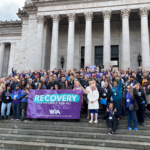
Our clients move mountains to make changes that work for them, achieve goals on their terms, and stay in treatment. We’ve walked alongside our participants as they crest peaks and navigate valleys for over 50 years.
Join us at this year’s Roots of Recovery gala to support ETS patients and staff through every switchback on the journey.
“Who decides to become addicted to drugs after having a kid?” That’s what Crystal, a substance use disorder professional here at ETS, asked us as she explained her path to drug use. “It just doesn’t work that way.” No one decides to become dependent on opioids, despite stigmatizing narratives suggesting otherwise.
Crystal works at ETS’ mobile medical unit—Treatment in Motion (TIM)—in Shelton. She’s been with ETS for three-and-a-half years and is celebrating six years without drugs. She began using substances at the age of 12, first casually using cannabis then progressing to alcohol and LSD. “I used a lot of different substances at a young, young age,” she explained. “But my life really became unmanageable when I started introducing illicit substances.”
Soon, Crystal began using heroin and meth. “I didn’t consciously make the decision to become addicted. It was a series of events that compounded upon each other. It really made a mess of my life.”
People tell you, ‘Just do what the authorities say.’ But when you’re deep in your addiction and the only thing you know is doing the ‘wrong’ thing, it’s really hard to do the ‘right’ thing.”
Years went by as Crystal continued to struggle with substance use. She married and had a daughter at the age of 30. Both she and her husband continued using harmful substances, and her husband was incarcerated when their daughter was 3 years old. “That would have been a great time for me to start my recovery journey, one would think,” Crystal said. “But I fell deeper into it, and it got harder.” When Crystal’s husband was released from prison, they both tried to stop using together.
Then things got “really, really bad.” Child Protective Services took Crystal’s daughter and placed her in foster care. “I was trying to navigate that while trying to find ways to keep using. It’s an experience that I would never wish upon anyone. People tell you, ‘Just do what the authorities say.’ But when you’re deep in your addiction and the only thing you know is doing the ‘wrong’ thing, it’s really hard to do the ‘right’ thing.”
Crystal and her husband made a choice to do everything they could to reunite with their daughter. They went through inpatient treatment, family reunification court, and regained custody in record time.
Throughout her initial recovery, Crystal felt called to become a counselor. Narcotics Anonymous had been incredibly impactful for her: “My NA family was always there for me.” She wanted to go to school to earn her degree, but she’d been using for many years without paying taxes. Crystal was concerned that her financial and legal standing would create obstacles in the application process, so she decided against it.
Shortly after reuniting with her daughter, Crystal experienced a relapse. To protect her husband’s recovery and their child from having to experience a tumultuous transition, her husband set a firm boundary with her: if she was going to live with them, she needed to stop using. But Crystal wasn’t ready to completely stop her use. She lived in her car for several months, and her life was “complete chaos.” She developed a concurrent gambling addiction while living on no income, a combination that led her to become involved in minor crime.
Before her recurrence of use, Crystal and her husband had planned to attend Clean and Free, a Narcotics Anonymous convention in Ocean Shores. Though they were still living separately, and Crystal was at a different point in her recovery than he was, she went to the convention. “I had one or two days clean, and I decided to go.” At the conference, her husband said she could come home to recover.
“I didn’t quite get it right away. I used one more time just to see, I guess. That was the deciding moment when I just couldn’t control my use: I couldn’t control the drugs; I couldn’t control the people I got the drugs from; I couldn’t control any of it. It was starting to make me miserable and angry again. I finally was ready to take matters into my own hands. I stopped my car, threw my drugs into the woods, went home, and told my husband, ‘Okay, I’m done.’”
“I was able to really take a look at my life and learn from everything that I had gone through.”
Family, she recalled, is a community of your own making. “I am lucky to have a very supportive family that was good at setting boundaries with me. And the people that were there the whole time, whether I was using or not, was my NA family.” Crystal said her support system was with her unconditionally—and their belief in her helped her take the next step in her recovery journey.
With the support of her husband and NA family, Crystal felt she had reached a turning point. “I was able to really take a look at my life and learn from everything that I had gone through.” She decided that she never wanted to live how she had been ever again. “I realized that my potential in this life is limitless if I’m not using drugs. When I was using I couldn’t accomplish anything. And in my recovery, I realized that I still wanted to be a counselor.”
Crystal earned her degree and began working for ETS where she’s been for the past several years. “I’m grateful that I get to work for an agency that creates opportunities for people who need it. My ETS family is really, really special to me.”
We asked Crystal what she thought about this year’s Roots of Recovery theme—Moving Mountains. “When I think of moving mountains, I think of our ability as individuals within this agency to make and instigate opportunities for change.” This also means expanding services to ensure that more
people have access to treatment on their terms. Crystal is part of a team working to provide transportation to the Shelton mobile clinic from North Mason County. “It’s a service desert up there, and people need access to medication and treatment,” she explained.
Today, Crystal encourages her patients and those she sponsors through NA to try everything if they really want to be in recovery and change their lives. “There’s never just one path of recovery. You never know what path is going to work for you. It could be medication for opioid use disorder, it could be a faith-based program, or a 12-step like it was for me. Different things work for different people, and recovery is possible.”
Crystal has moved many mountains on her own journey and with her patients. But her most important lesson has been learning to take recovery one day at a time, and sometimes one minute or second at a time. “Saying to yourself, ‘I’m not going to use for this one minute’ can turn into hours and days and years and decades.”




